Greedy Algorithms
Theory
A greedy algorithm is any algorithm that follows the problem-solving heuristic of making the locally optimal choice at each stage. In many problems, a greedy strategy does not usually produce an optimal solution, but nonetheless, a greedy heuristic may yield locally optimal solutions that approximate a globally optimal solution in a reasonable amount of time.
In computer science, a problem is said to have optimal substructure if an optimal solution can be constructed from optimal solutions of its subproblems. This property is used to determine the usefulness of dynamic programming and greedy algorithms for a problem.
Simple Example
A greedy algorithms determine the minimum number of coins to give while making change. These are the steps most people would take to emulate a greedy algorithm to represent 36 cents using only coins with values {1, 5, 10, 20}. The coin of the highest value, less than the remaining change owed, is the local optimum. (In general, the change-making problem requires dynamic programming to find an optimal solution; however, most currency systems, including the Euro and US Dollar, are special cases where the greedy strategy does find an optimal solution.)
Kruskal’s Minimum Spanning Tree
Given a connected and undirected graph, a spanning tree of that graph is a subgraph that is a tree and connects all the vertices together. A single graph can have many different spanning trees. A minimum spanning tree (MST) or minimum weight spanning tree for a weighted, connected, undirected graph is a spanning tree with a weight less than or equal to the weight of every other spanning tree. The weight of a spanning tree is the sum of weights given to each edge of the spanning tree.
How many edges does a minimum spanning tree has?
A minimum spanning tree has (V – 1) edges where V is the number of vertices in the given graph.
Algorithm
- Sort all the edges in non-decreasing order of their weight.
- Pick the smallest edge. (When picking the edge, chioce of edge can be adjacent to prior choosed edges or not). Check if it forms a cycle with the spanning tree formed so far. If cycle is not formed, include this edge. Else, discard it.
- Repeat step#2 until there are (V-1) edges in the spanning tree.
Step#2 uses the Union-Find algorithm to detect cycles.
Prim’s Minimum Spanning Tree
Like Kruskal’s algorithm, Prim’s algorithm is also a Greedy algorithm. It starts with an empty spanning tree. The idea is to maintain two sets of vertices. The first set contains the vertices already included in the MST, the other set contains the vertices not yet included.
At every step, it considers all the edges that are from the cut (A group of edges that connects two set of vertices in a graph is called cut in graph theory), and picks the minimum weight edge from these edges. After picking the edge, it moves the other endpoint of the edge to the set that containing MST.
Algorithm
- Create a set
mstSetthat keeps track of vertices already included in MST. - Assign a key value to all vertices in the input graph. Initialize all key values as
INFINITE. Assign key value as 0 for the first vertex so that it is picked first. - While
mstSetdoesn’t include all vertices- Pick a vertex u which is not there in mstSet and has minimum key value.
- Include u to mstSet.
- Update key value of all adjacent vertices of u. To update the key values, iterate through all adjacent vertices. For every adjacent vertex v, if weight of edge u-v is less than the previous key value of v, update the key value as weight of u-v
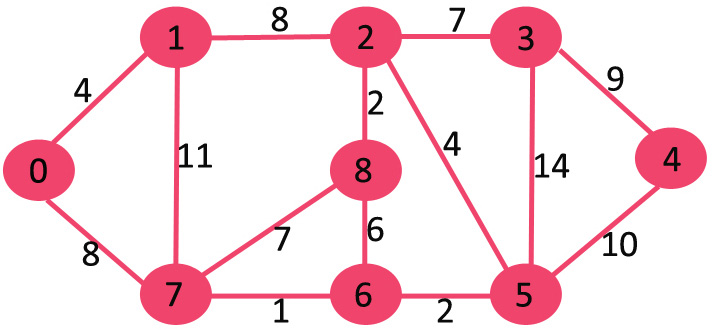
The set mstSet is initially empty and keys assigned to vertices are {0, INF, INF, INF, INF, INF, INF, INF} where INF indicates infinite. Now pick the vertex with the minimum key value. The vertex 0 is picked, include it in mstSet. So mstSet becomes {0}. After including to mstSet, update key values of adjacent vertices. Adjacent vertices of 0 are 1 and 7. The key values of 1 and 7 are updated as 4 and 8. Following subgraph shows vertices and their key values, only the vertices with finite key values are shown. The vertices included in MST are shown in green color.

Pick the vertex with minimum key value and not already included in MST (not in mstSET). The vertex 1 is picked and added to mstSet. So mstSet now becomes {0, 1}. Update the key values of adjacent vertices of 1. The key value of vertex 2 becomes 8.
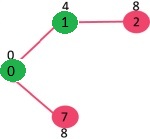
Pick the vertex with minimum key value and not already included in MST (not in mstSET). We can either pick vertex 7 or vertex 2, let vertex 7 is picked. So mstSet now becomes {0, 1, 7}. Update the key values of adjacent vertices of 7. The key value of vertex 6 and 8 becomes finite (1 and 7 respectively).
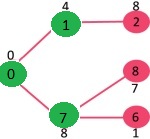
Pick the vertex with minimum key value and not already included in MST (not in mstSET). Vertex 6 is picked. So mstSet now becomes {0, 1, 7, 6}. Update the key values of adjacent vertices of 6. The key value of vertex 5 and 8 are updated.
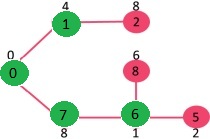
We repeat the above steps until mstSet includes all vertices of given graph. Finally, we get the following graph.
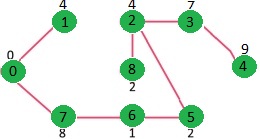
Dijkstra’s algorithm
Given a graph and a source vertex in the graph, find the shortest paths from the source to all vertices in the given graph.
Dijkstra’s algorithm is very similar to Prim’s algorithm for minimum spanning tree. Like Prim’s MST, we generate a SPT (shortest path tree) with a given source as a root. We maintain two sets, one set contains vertices included in the shortest-path tree, other set includes vertices not yet included in the shortest-path tree. At every step of the algorithm, we find a vertex that is in the other set (set of not yet included) and has a minimum distance from the source.
Algorithm
- Create a set
sptSet(shortest path tree set) that keeps track of vertices included in the shortest-path tree, i.e., whose minimum distance from the source is calculated and finalized. Initially, this set is empty. - Assign a distance value to all vertices in the input graph. Initialize all distance values as
INFINITE. Assign distance value as 0 for the source vertex so that it is picked first. - While
sptSetdoesn’t include all vertices- Pick a vertex u which is not there in sptSet and has a minimum distance value.
- Include u to sptSet.
- Update distance value of all adjacent vertices of u. To update the distance values, iterate through all adjacent vertices. For every adjacent vertex v, if the sum of distance value of u (from source) and weight of edge u-v, is less than the distance value of v, then update the distance value of v.